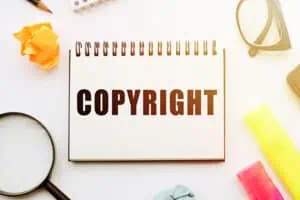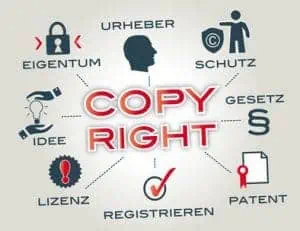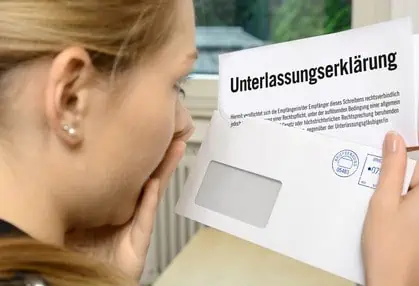Copyright law - violations can be expensive!
Copyright law and its protective mechanisms form the backbone for creativity, innovation and the appropriate remuneration of creative and creative work.
But what exactly is behind this complex area of law?We dive into the world of copyright and copyright law, shed light on its importance for creators, originators and consumers, and show how it is applied in our networked society.
From the basic principles to the protected works to the claims that creators are entitled to in case of infringement in the digital age, we will present the most important aspects of copyright and copyright law and its role in our modern information society.

Content
- What does copyright mean and what does the Copyright Act regulate?
- Which works are protected under the Copyright Act?
- What rights are due to the creator of a work or the author?
- When is there an infringement of copyright?
- What is meant by a warning notice in the area of copyright protection?
- What claims does the author have?
- Copyright law: How can a specialist lawyer help me?
1. What does copyright mean and what does the Copyright Act regulate?
Copyright is a property right that protects intellectual creations of natural persons. Personal intellectual creations are also referred to as works and the creators as (creative) authors. The Copyright Act - UrhG for short - regulates the largest part of German copyright law and protects personal intellectual creations or works of literature, science and art (Section 2 UrhG).
In addition to the regulations on the protection of works, the Copyright Act also contains regulations on the use and exploitation of intellectual creations. In the second part of the Copyright Act, further ancillary copyrights and related rights are standardized, which primarily concern the communication of the works to the public and the marketing as goods or services.
Protection of works without registration
Unlike patents or trademarks, for example, a work does not have to be applied for or registered with an institution or authority in order to fall under the protection of copyright. The Copyright Act was passed in 1965 and came into force on 01.01.1966.
It thus replaced the Law on Copyright in Works of Literature and Sound Art - LUG for short - of 1901 and the Law on Copyright in Works of Fine Arts and Photography - KUG, KunstUrhG or Kunsturhebergesetz for short - of 1907. Parts of the Kunsturhebergesetz, in particular §§ 22 - 24 KUG, are still in force today and are relevant to the general right of personality in the form of the right to one's own image.
Copyright as intellectual property law
Copyright belongs to the law of intellectual property (internationally also called Intellectual Property - or IP for short) and thus to intangible property law. Intellectual property is understood to be non-corporeal objects that have an economic and non-material value.
Due to the lack of physicality, intangible property cannot be protected by property law, so that protection is linked to the intellectual property. In addition to personal intellectual creations, this also applies, for example, to trademarks, inventions/patents and designs.
However, in contrast to the other intellectual property rights, copyright is not part of industrial property protection, as copyright is not limited to the commercial sector but also covers private use.
2. Which works are protected under the Copyright Act?
An intellectual creation of literature, science or art is an intellectual and creative achievement of a human being. In doing so, the person can use aids or tools. The concept of aids/tools is open to all technologies, so that both brushes, pencils, hammers or chisels, for example, and the use of machines or computers can be considered as aids in the creative performance.
Due to the technology neutrality of copyright law, creative results achieved with the help of a lathe, a 3D printer or artificial intelligence, for example, also fall under copyright law and the protection of copyright law.
Particularly in the case of results produced by the use of AI, however, the question arises as to whether humans are engaged in creative activity with the help of AI or whether AI already produces independent works that may no longer be amenable to copyright. Purely computer-generated or AI-generated works do not qualify as works due to the lack of intellectual creation by a natural person.
The work - Section 2 UrhG
§ Section 2 (1) UrhG contains a non-exhaustive list of independent intellectual creations or categories of works of literature, science and art that qualify as works. Two requirements can be derived from this:
it must be a personal intellectual creation (Section 2 (2) UrhG)
it must be a creation of literature, science or art (Section 2 (1) UrhG).
The following categories of works are mentioned in § 2 para. 1 UrhG:
Linguistic works
- Writings
- Texts
- Speeches
- Computer programs
- Books
- E-books
- Magazines
Works of music
- Pieces of music
- light music
- classical music
- musicals
- Audio books and plays
Pantomime works
- Dance choreographies (e.g. as a performance by a choreographer)
Works of fine arts (including architecture and applied arts)
- Paintings
- Paintings
- Drawings
- Statues
- Tattoos on human skin
- Buildings
Photographic works
- Photographic works are, for example, photographs that reach a certain level of creation.
- photographs
Cinematographic works
- motion pictures and television films
- Commercials
- music videos
representations of a scientific or technical nature
- scientific and technical drawings
- exploded views
Other works
The categories of works under Section 2 (1) UrhG have in common that the creators do not create these works out of "nothing". The creators have skills, even if they are only basic human skills, which are processed to then be used in works protected by copyright. Copyright law nevertheless regards them as independent works and thus as originals.
Arrangements - § 3 UrhG
While independent works are subject to copyright law and its protection, creative adaptations of existing works may also fall under the protection of copyright law. An adaptation exists, for example, if individual elements are inserted into an existing work. An expression of individual creation is the retention or modification of individual elements or the new composition of existing elements.
If these creative changes and adaptations also represent personal intellectual creations, they are also protected as in Section 2 UrhG.
Examples of adaptations according to § 3 UrhG are, for example:
- the translation of a linguistic work
- the creation of a screenplay
- the filming of a narrative or linguistic work
- the change of a piece of music into another musical form, e.g. jazz or the modernization of a hit song
- the reproduction of a work of art in other art forms, e.g. a painting is transformed into a sculpture
Collective works and database works - Section 4 UrhG
Another form of using existing works is the creation of collective works and database works. Against the background of growing cultural stocks, the need arose to collect and structure them or to prepare them systematically. In the analog age, this was done, for example, in the form of encyclopedias or yearbooks. In the digital age, databases are used for this purpose, for example.
The collection of works and other independent components is referred to as a collective work under Section 4 (1) UrhG. Due to the selection, structure or arrangement of the works or contents, such collective works are protected as intellectual creations worthy of protection. The same applies to the electronic or digital version, the database (Section 4 (2) UrhG).
Are you looking for a lawyer for trademark law, copyright law or competition law in Hamburg?
Then call us now at (040) 3501 6360 or write a mail to info@kanzlei-bennek.de.
3. What rights are due to the creator of a work or the author?
The author and his protection are at the center of copyright law. The author's work is a personal intellectual creation. The creator of the work is referred to as its author, since he has given form and shape to his creativity in the form of the work (Section 7 UrhG). According to Section 11 UrhG, the author's rights include both his intellectual and personal relationship to the work (moral rights - Sections 12 to 14 UrhG) and the use and exploitation of the work (Sections 15 ff. UrhG) as well as other rights (Sections 25 - 27 UrhG).
Moral rights of the author - §§ 12 to 14 UrhG
If a person has created a work, the moral right arises and the work is protected by copyright. The moral right is not transferable, but passes to the heir in the event of death.
It includes
- the right of publication - § 12 UrhG
- the right to acknowledge authorship - § 13 UrhG
- and the right to prohibit the distortion of the work - § 14 UrhG.
According to § 14 UrhG, the author can prohibit that his work is distorted or otherwise interfered with the substance of his work. Even after the transfer of the rights of use, the author has a legitimate interest in ensuring that his work is made available to the public in the manner determined by him, e.g. that it is exhibited in unaltered form.
Right of use and exploitation - §§ 15 ff. UrhG
The exploitation rights secure the author, among other things, a financial remuneration for the use of his work. Only the author can decide how and in what form his work is used and what is done with his work.
§ Section 15 UrhG contains a non-exhaustive list of exploitation rights. The rights enumerated in Section 15(1) UrhG include the author's exclusive right to exploit the work physically (Sections 16 - 18 UrhG); Section 2 contains an enumeration of the rights to reproduce the work in public in a nonphysical form (Sections 19 - 22 UrhG).
These include:
- Reproduction right - 16 UrhG
- distribution right - 17 UrhG
- right of exhibition - 18 UrhG
- Right to lecture, perform and present - 19 UrhG
- Right of making available to the public - 19a UrhG
- Broadcasting right - 20 UrhG
- Right of reproduction by means of image or sound carriers - 21 UrhG
- Right of reproduction by radio broadcasting and making available to the public - 22 UrhG
4. When is there a copyright infringement?
Copyright infringement occurs when the rights of an author are infringed. Most copyright infringements are in the area of violation of the author's exploitation rights, in that a protected work is reproduced without permission or used without permission, e.g. on a homepage or in an offer for sale (eBay/classified ads). Such use usually affects the financial remuneration of the author, since he can no longer decide whether and how his work is used.
However, it is also possible that unauthorized actions and uses impair the author's relationship to his work and thus fall within the scope of moral rights. Such an infringement may occur if there is an unauthorized transformation or adaptation of a work, i.e. if the title or the content of a work has been changed without permission.
Copyright infringement on the Internet
Especially in the area of Internet use, there are often careless actions that can very quickly lead to copyright infringement. In the areas of file sharing, streaming or pirated copies, the risk of copyright infringement is particularly high, but also relatively easy to avoid.
Internet users who adhere to the following rule are immune to copyright infringement: copyright-protected content must not be uploaded or downloaded. Behavior to the contrary represents either an infringement of the author's exploitation rights when downloading or an infringement of the right of public access when uploading.
But no rule without exception! Some things are possible without the risk of copyright infringement. To make this clear, the most practically relevant pitfalls are shown here.
Copyright infringement through file sharing
File sharing occurs when files are exchanged between Internet users, e.g. via file sharing networks or certain programs. The files are copyrighted works such as music, e-books, movies, software, etc. The exchange takes place in a peer-to-peer (P2P) network.
In this process, the download is shared among users, which increases the loading speed and automatically redistributes the file. This means that the download is also associated with a download for other users. The user thus becomes a provider of copyrighted material himself and thus infringes the rights of the creators and rights holders. Rights owners and copyright holders often commission so-called anti-piracy companies to log the IP addresses of users.
By means of injunctions, the Internet providers can assign the IP addresses to the respective users. The Internet providers can then be required by court order to hand over the respective connection data to the copyright holders or their lawyers.
The law firms commissioned by the rights holders then often send a large number of warning letters to the identified users who have made the files available for download. Incidentally, it does not matter whether the file-sharing user knew about the download or wanted it.
The law firm Waldorf Frommer is one of the warning law firms that very often act as a warning law firm.
Copyright infringement through pirated and private copying
Not every download or upload constitutes copyright infringement. Uploading a file containing copyrighted material from the Internet does not constitute copyright infringement. If this happens in a non-public cloud, for example, there are no legal problems.
Copyright infringement only occurs if the copyrighted material is also distributed publicly, i.e. in a public cloud or P2P network.
Sending a file with copyrighted content by e-mail to another person also does not constitute copyright infringement, since there is no public distribution here either.
The same applies to pirated copies. A pirated copy is the unauthorized duplication of copyrighted material. The origins of piracy lie in analog recordings of music from television and radio broadcasts or from records. However, these involved considerable loss of sound quality due to the technology used and available at the time.
With the help of digital technology, copying a CD or DVD, for example, is possible in many cases without any major loss of quality. Making such a copy is not prohibited per se. According to Section 53 of the German Copyright Act, such pirated copies, as long as they are only made in small numbers and distributed among close friends and relatives, are merely considered private copies.
However, the borderline to illegal piracy is likely to be crossed if many copies are made and distributed among acquaintances and work colleagues, for example.
Copyright infringement through streaming
A few years ago, there were portals such as kino.to that offered a great deal of copyrighted content for streaming in German-speaking countries. At that time, this was a legal gray area. In many cases, it was argued that streaming copyrighted material was legally unobjectionable and that merely retrieving content via streaming did not constitute copyright infringement.
When streaming, the content is not permanently stored on the computer. The content is only stored in the PC's cache for the duration of viewing. This therefore represents a difference from downloading content.
While this fell into the gray area of copyright infringement for a long time, this has changed since a ruling by the ECJ. The ECJ ruled in 2017 (Case C-527/15) that merely watching copyrighted content such as movies or series also constitutes copyright infringement. The prerequisite is that the content is obviously illegal for the user.
However, the ECJ did not define what exactly is "obviously illegal." In the case of a new movie that has just been released in theaters, for example, it must be obvious to the user that the content on offer is illegal.
Thus, even the temporary storage of films for a short period of time, e.g. by means of a stream, infringes the rights of the copyright holder.
The use of streaming services or the viewing of official and free streams, e.g. from TV stations or other official live streams, on the other hand, does not constitute copyright infringement.
Copyright infringement through use of photos (image theft)
On the Internet, it is very easy for users to find and save images. However, it is much more difficult to recognize whether these photos, be they, for example, landscape photographs, pictures of products or other items for sale, are protected by copyright or are subject to such protection. Such protection does not have to be explicitly mentioned, nor, for example, does a copyright sign have to have been used. The copyright sign has no meaning under German law.

A classic case of "image theft", i.e. the unlawful use of copyrighted images, is the use on sales platforms. If you want to sell an item yourself that is frequently offered on sales platforms such as eBay, Etsy, Vinted or classifieds, you could simply take the image from another auction/offer and use it for your item.
If, however, someone else has taken the trouble to photograph the product and perhaps also staged the item in a special way, such photos are usually a photographic work protected by copyright because they have reached a certain level of creation. Use in one's own sales offer is then not legally permissible without the consent of the copyright holder.
Photographs are protected by copyright both as photographic works and as mere photographs. While photographic works must have a certain level of creativity, which must be examined in each individual case, simple snapshots such as vacation photos or party photos fall under the concept of a photographic work. In the case of photographic works, a certain creative or creative achievement must be recognizable, such as the photographing of a specific product, the choice of motif/image detail or a special exposure (e.g. long exposure).
Internet users should therefore never use third-party photos for their own homepage, blog or sales offers. Such unauthorized use is one of the most common copyright infringements on the Internet. Warning letters can be the consequence.
5. What is meant by a warning notice in the area of copyright protection?
If an author or holder of rights of use and exploitation discovers that other persons have used a copyrighted work, or if he or she has used a copyrighted work without appropriate permission, this constitutes a copyright infringement, which often leads to a warning notice.
The warning notice is a formal notification of the infringement and the assertion of the author's claims. This is accompanied by a request to refrain from such behavior in the future. In this way, costly and lengthy legal proceedings can be avoided.
The party who has infringed the rights of the copyright holder is often requested to submit a cease-and-desist declaration with a penalty clause.

You can read more on the topic of cease-and-desist letters in our article on the subject.
In doing so, he undertakes to refrain from the copyright infringement in the future. In the event that the infringement continues, he is obliged to pay the contractual penalty agreed in the cease-and-desist declaration, similar to a fine.
Such a declaration should only be made after legal advice from a specialist lawyer if you yourself have infringed the rights of an author.
A warning notice should always be issued by a lawyer. The legal fees for the warning are borne by the party who has infringed the rights. For consumers, the lawyer's fees for the warning are limited to 150 €. For companies, higher costs may be incurred.
6. What claims does the author have?
The Copyright Act provides for several claims to which the author or the holder of rights of use and exploitation is entitled if his rights are infringed. The most important of these are the right to injunctive relief, the right to removal and the right to damages (Section 97 UrhG).
Injunctive relief - Section 97 (1) sentence 1 UrhG
If there is a risk that the infringer will repeat the copyright infringement, the author has a right to injunctive relief, i.e. the infringer must refrain from infringing.
Right of removal - Section 97 (1) sentence 1 UrhG
If the right to cease and desist alone is not sufficient to remedy the copyright infringement, the author is entitled to a claim for removal. The infringer must then ensure that the copyright infringement is removed.
Claim for damages - Section 97 (2) sentence 1 UrhG
If the infringer is at fault for the copyright infringement (intent or negligence), the author is entitled to claim damages. Section 97 (2) UrhG of the Copyright Act provides for three variants of damages from which the author can choose:
- Compensation for the damage incurred
- Payment of the profit made
- Payment of a fictitious reasonable license fee if the infringer would have obtained a license.
In addition, the infringer is obliged to pay the legal fees incurred.
7. copyright law: How can a specialist lawyer help me?
If your company has received a warning letter for copyright infringement, you should seek expert help immediately.
In particular, make sure that the lawyer is professionally qualified.
The regulations of copyright law represent a special legal matter, especially in the commercial sector. It is therefore advisable to consult a specialist lawyer for industrial property rights.
In a first step, the specialist lawyer for industrial property rights will check whether it is actually a case of copyright infringement. If this is the case, the specialist lawyer will usually work towards a reduction of the legal costs and the compensation for damages.
In addition, when issuing the cease-and-desist declaration, he makes sure that no excessive or disproportionately high contractual penalties are agreed. As a rule, a modification of the cease-and-desist declaration sent along is necessary in this context.
There is a risk that the author will obtain an injunction before the competent court if you do not respond to a cease-and-desist letter in good time. This is associated with additional court costs. In addition, you will then have an enforceable title which, in the event of a repeated infringement, can be punished with an administrative fine or even imprisonment.
So do not hesitate to contact a specialized lawyer in good time.
Do you have any questions or would you like to make an appointment?
Then call us now at (040) 3501 6360 or write a mail to info@kanzlei-bennek.de.
Picture credits: DatenschutzStockfoto, Trueffelpix – fotolia.com



